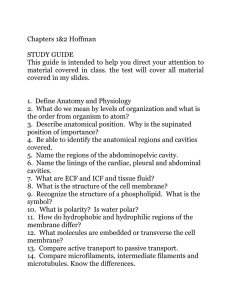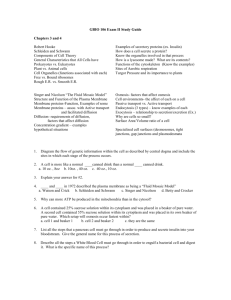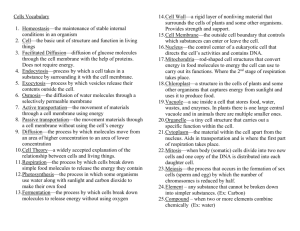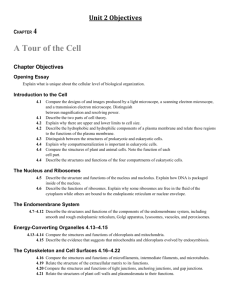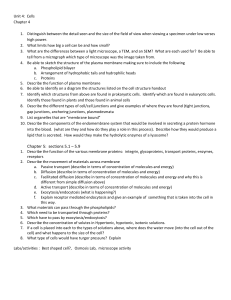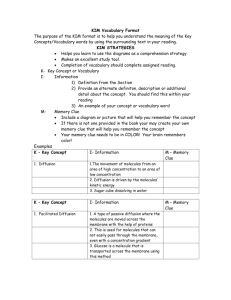Study Guide Test 1, Basic Chemistry, Cell Structure & Physiology
advertisement
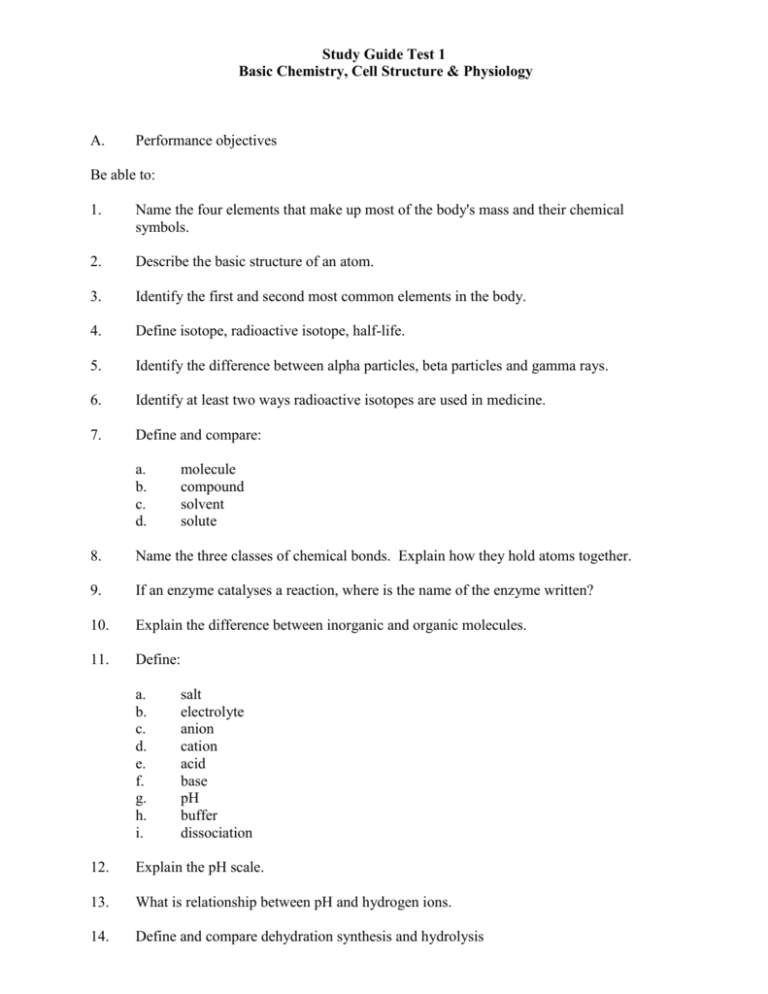
Study Guide Test 1 Basic Chemistry, Cell Structure & Physiology A. Performance objectives Be able to: 1. Name the four elements that make up most of the body's mass and their chemical symbols. 2. Describe the basic structure of an atom. 3. Identify the first and second most common elements in the body. 4. Define isotope, radioactive isotope, half-life. 5. Identify the difference between alpha particles, beta particles and gamma rays. 6. Identify at least two ways radioactive isotopes are used in medicine. 7. Define and compare: a. b. c. d. molecule compound solvent solute 8. Name the three classes of chemical bonds. Explain how they hold atoms together. 9. If an enzyme catalyses a reaction, where is the name of the enzyme written? 10. Explain the difference between inorganic and organic molecules. 11. Define: a. b. c. d. e. f. g. h. i. salt electrolyte anion cation acid base pH buffer dissociation 12. Explain the pH scale. 13. What is relationship between pH and hydrogen ions. 14. Define and compare dehydration synthesis and hydrolysis 15. Describe and distinguish between monosaccharides, diaccharides and polysaccharides. 16. Distinguish between phospholipids and steroids such as cholesterol. 17. Know the functions and differences between DNA and RNA 18. Know the function of ATP and ADP and be able to recognize the difference between these two molecules. 19. Describe the structure of amino acids, including their functional groups. 20 Describe the formation of a peptide bond, glycosidic and ester bond. 21. Know the difference between saturated and unsaturated fats. 22. Identify trans and cis fatty acids and describe their significance. 23. Define tonicity, isotonic, hypotonic and hypertonic. 24. Understand the factors that affect diffusion rate. 25. Describe the structure and function of desmosomes, gap junctions and tight junctions. 26. Define osmotic pressure. 27. Explain what selectively or semi-permeable means. 28. Describe the difference between simple diffusion and facilitated diffusion. 29. Know the difference between primary and secondary active transport. 30. Define membrane potential, resting potential, depolarization & repolarization. 31. Describe the difference between symport and antiport. Also co-transport and counter transport 32. Explain how the membrane potential is maintained. 33. Know how to use and solve problems using the Nernst Equation. 34. Be able to briefly describe the terms in the Nernst Equation. 35. Describe the significance of the Goldman Equation. 36. Describe vesicular transport. 37. Define filtration. 38. Briefly explain the Na/K pump. B. Sample Questions 1. Carrier-mediated transport (facilitated diffusion) transport: a. is not limited by the number of carrier proteins b. is limited by the amount of ATP present c. is limited by the amount of ATPase present d. is limited by the number of number of carrier proteins present. e. never gets saturated 2. When substances move across the cell membrane in opposite directions simultaneously the transport system is know as a __________system. a. symport system b. co-transport system c. antiport system d. counter transport system e. 3 and 4 3. Gap junctions function to: a. are impermeable junctions that circle the cell b. bind adjacent cells together c. transport ions and other small molecules d. contain connexons e. 3 and 4 4. Which is disaccharide? a. glucose b. ribose c. fructose d. sucrose e. galactose 5. Excitable cells: a. are all cells that have a membrane potential b. include neurons and skeletal muscle cells c. include liver and kidney cells d. show self-generating waves of electronegativity when stimulated e. b and d
